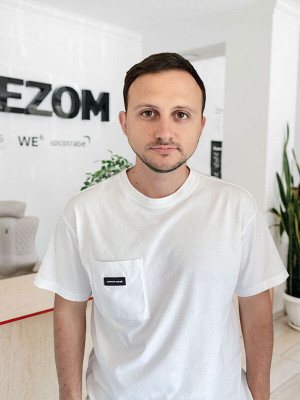It has been for a long time that the OpenAI company, which is engaged in developing innovative AI tools, such GPT, DALL-E and Codex, is widely popular. Mainly due to its smart chat-bot ChatGPT…But the possibilities for leveraging the extensive language model of ChatGPT and other OpenAI tools is far wider than it seems.
In the process of logistics software development, OpenAI models that are integrated with the help of APIs can be used, in order to extend its functionality and its potential, and to make it more useful and advanced. This article will discuss how the AI tools are already used in logistics, and why exactly you should pay attention to this aspect.
How Do AI Tools Assist Logistics Businesses?
A modern AI-powered logistics platform is already able to perfect logistics processes in an organization on all of the levels. For example:
- Demand forecasting. Artificial intelligence helps companies to use data in the real-time mode for forecasting the consumer’s demand and optimizing inventory.
- Supply planning. AI in the logistics industry helps businesses dynamically update the parameters of their supply chains depending on the changes in the demand and the relevant market realities.
- Warehouse works. A large number of companies use AI to optimize such warehousing operations as sorting, picking, packing and moving goods using robotic systems that can work faster and more accurately than a human.
- Route optimization. AI can quickly and precisely analyze data regarding traffic, weather conditions, and other factors in order to optimize the
- Analysis of the client behavior. AI can help suppliers to better understand the preferences, needs, and expectations of their clients, as well as to offer them relevant and personalized services and recommendations.
And this is just a tiny part. There are plenty of options for implementing AI tools!
DIfferent AI-Powered Tools in Transportation and Logistics
Let’s have a look at how AI helps logistics by using the examples of the already existing tools by OpenAI:
- OpenAI Codex is a system which generates code based on descriptions or examples in native language.
- OpenAI GPT is a large language model which is capable of generating texts on various topics. It can help transportation and logistics companies to improve communication with clients, suppliers, and partners in different languages, as well as to create marketing materials, improve the way they serve clients, and so on.
- OpenAI DALL-E is a system that generates images based on text descriptions. This platform can help in the development of new products, logos, packaging and other visual elements.
- OpenAI CLIP is a tool capable of classifying images, videos, sounds and texts based on text labels and captions. OpenAI CLIP can help transport and logistics companies recognize objects, scenes, actions, and events in their data.
- OpenAI Microscope is a set of feature visualizations that can help transportation companies improve their vision systems and applications.
Other OpenAI tools also find their application: OpenAI Baselines, OpenAI Gym, OpenAI Spinning Up. The list will certainly be expanded and updated in the future.
Future Use of Chat GPT for Logistics Software
We are on the verge of truly global changes in the field of logistics and transport. These changes include the following ways to use artificial intelligence:
| Ways to use artificial intelligence | In Detail |
| Automated answers to frequently asked questions. | Use ChatGPT for instant answers to frequently asked questions about deliveries, scheduling, ELD compliance, and other logistical questions. |
| Troubleshooting guide | Develop a ChatGPT-based system to help users solve logistics software problems by providing step-by-step assistance based on the problem description. |
| Automated reporting | Use ChatGPT to quickly generate clear reports based on data from the software. |
| Order management | Use the OpenAI API to process orders and purchase requests using natural language processing. |
| Proactive alerts and notifications | Integrate ChatGPT with your software to send personalized notifications. For example, information about a change in delivery schedule or fleet maintenance. |
| Learning tools | Use smart chatbots to train new employees in the efficient use of logistics software. |
| Intelligent assistant | Create an intelligent assistant to help with schedule planning, route planning and cargo management. |
| Communication with drivers | Integrate the ChatGPT API with software to automate and simplify communication with drivers, converting their messages into payloads or providing real-time assistance. |
| Regulation and compliance | Use ChatGPT to inform users about regulatory requirements such as driver hours regulations and ELD compliance. |
| Feedback from users | Collect and analyze user feedback using the OpenAI API to gain valuable insights to improve your software. |
And this is just what we can see very soon. In the long term, technological solutions will certainly be much more revolutionary.
Taxonomy of AI that Can be Used in Logistics
Taxonomy in transport and logistics is the classification and systematization of modes of transport, cargo, routes and other elements of logistics infrastructure in order to optimize delivery processes and manage logistics flows.
In logistics, AI taxonomy is already being applied today in:
- Rule based AI. AI systems follow predefined rules and criteria to make predictions and recommendations on logistics processes.
- AI with supervised learning. Artificial intelligence learns from the data it receives to predict the demand for products and services.
- Prediction of expected arrival time and customs clearance time. AI optimizes cargo delivery routes to optimize costs, taking into account external factors such as traffic congestion, weather conditions, and the like.
- AI for natural language processing. Artificial intelligence understands and analyzes human language, monitors customer reviews and moods, and helps improve feedback.
- Agent based AI. AI can identify future trends and suggest strategies for increasing logistics capacity.
That is, artificial intelligence can really improve the efficiency and quality of logistics processes, as well as reduce costs and even reduce carbon emissions.

Real-world use Cases Where AI-based TMS Upgrades Have Shown Improved Profits
Alan Shaw, Director of Account Operations at PCS Software, spoke with a Freight Waves representative:
“Companies that can automate are discovering they can do more with less. About 40% of the time trucks move around the US empty. AI-powered tools are able to optimize routes in such a way as to reduce this number by up to 10%.”
The results of how the AI-powered logistics platform optimizes workflows and allows you to earn more are already visible:
- Infocepts developer helped a global market research company automate its reporting process with AI, saving about $1 million annually.
- Today, software from the aforementioned PCS is helping shippers and carriers optimize their operations with the help of AI and reduce fuel costs and empty miles.
- Many companies, such as Lilt, Unbabel, Lionbridge and AppTek, have already implemented AI voice, thereby optimizing a number of work tasks. Especially in terms of communication with clients.
Our TMS (Transport Management System) is a tool that helps you understand delivery data and improve performance, get real-time information about each vehicle, analyze their efficiency, automate workflows, simplify and speed up order processing, and much more. other.
Also, do not forget that AI in the field of logistics can be effectively used not only on the desktop, but also on mobile devices. We have already looked at some AI tools for mobile applications. We highly recommend you check it out!
Future Trends and Forecasts
The use of AI in logistics right now is qualitatively changing the industry itself. But it is clear that major changes await us in the future. Here are just some of the forecasts in this area that experts share:
- AI telematics will begin to develop even faster. It will provide real-time driver monitoring and training, as well as predictive analytics for fleet management. According to Forbes, AI telematics is expected to grow at a CAGR of 17.87% per year. And the market volume by 2030 will exceed 10.3 billion dollars.
- Transportation Management Software (TMS) will become increasingly intelligent and deeply integrated. This, in turn, will allow better planning, execution and control of the movement of goods. According to Gartner, the TMS market will grow to $2.11 billion by 2024.
- Multi-channel logistics will also develop. In particular, to achieve greater transparency, personalization, efficiency and speed of delivery. For example, McKinsey believes that the transport and logistics industry must be as digital as possible in order to secure its own future and meet the growing needs of customers.
In addition, AI in logistics and supply chain can revolutionize the transport and logistics industries in the near future, reducing labor costs, increasing safety and efficiency. For example, researchers from PwC believe that autonomous trucks can reduce the cost of long-haul transportation by 28% or more. And drones will be able to deliver packages faster and cheaper than conventional methods allow.
Summing up all of the above, we can say that you need to start the process of introducing artificial intelligence tools into the logistics and transport system of your business right now, so that in a couple of years or even months you won’t be “overboard”. That is why we offer you our own solutions based on AI. In particular, TMS is a transport management system that can be flexibly configured specifically for your tasks.
Contact a WEZOM representative for details and to discuss all the details. We create individual solutions for each client!



